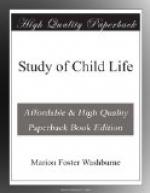[Sidenote: Classic Art]
Since photogravures and photographs of the masterpieces can be had in this country very inexpensively, there is no reason why children should not be made acquainted at an early age with the art classics, but there is danger in giving too much space to black and white, especially in the nursery where the children live. Their natural love of color should be appealed to do deepen their interest in really good pictures.
[Illustration: “My Mary”]
[Illustration: “Blow, Wind Blow”
PERKINS’ PICTURES]
Nevertheless, it is a matter of considerable difficulty still to find colored pictures which are inexpensive and yet really good. The Detaille prints, while not yet cheap, are not expensive either, and are excellent for this purpose; but the insipid little pictures of fairies, flowers, and birds may be really harmful, as helping to form in the young child’s mind too low an ideal of beauty—of cultivating in him what someone has called “the lust of the eye.”
[Sidenote: Plastic Art]
What holds true of the pictorial art holds equally true of the plastic art. As Prof. Veblin of the University of Chicago has scathingly declared, our ideals of the beautiful are so mingled with worship of expense that few of us can see the genuine beauty in any object apart from its expensiveness. For this reason as well as, perhaps, because of a remnant of barbarism in us, we love gold and glitter, and a great deal of elaboration in our vases, and are far from being over-critical of any piece of statuary which costs a respectable sum.
[Illustration: RELIEF MEDALLION
By Andrea della Robbia, in Foundling Hospital, Florence.]
A certain appreciation, however, of the real value of a good plaster-cast has been gaining among us of late years, and many public schools, especially in the large cities, have been establishing standards of good taste in this respect. Good casts and bas-relief, decorate their halls and class-rooms. There are few homes that cannot afford to follow their example. But in buying these things be not misled by sales and advertised bargains. It is more than seldom that the placques, casts, and vases thus obtained are such as could have any valuable influence whatever upon the young lives with which they are brought in contact. Meretricious and showy ornaments, designed to look as if they cost more than they really do, have no business in the sincere home where the children are being sincerely educated.
[Sidenote: Music]
The same general laws apply to music. No art has a greater and more insinuating influence. The very songs with which the mother sings the baby to sleep have an occult influence which is later revealed and made plain. Such songs, then, should be simple. They may be nothing but improvisations, the mother’s mind and heart making music, but they should not be melodramatic songs of the music-hall order. No such mawkish sentimentalism as that shown in “The Gypsy’s Warning,” for example, or other songs which belong to the cheap theater should have a place in the holy of holies—that inmost self of the child—which responds to music.




